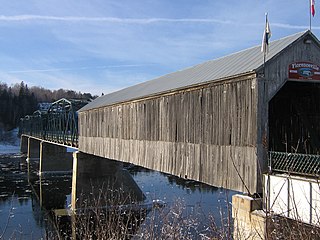
Florenceville-Bristol is a former town in the northwestern part of Carleton County, New Brunswick, Canada along the Saint John River. It held town status prior to 2023 and is now part of the town of Carleton North.

Woodstock is a town in Carleton County, New Brunswick, Canada on the Saint John River, 103 km upriver from Fredericton at the mouth of the Meduxnekeag River. It is near the Canada–United States border and Houlton, Maine and the intersection of Interstate 95 and the Trans-Canada Highway making it a transportation hub. It is also a service centre for the potato industry and for more than 26,000 people in the nearby communities of Hartland, Florenceville-Bristol, Centreville, Bath and Lakeland Ridges for shopping, employment and entertainment.

The Saint John River is a 673-kilometre-long (418 mi) river flowing within the Dawnland region from headwaters in the Notre Dame Mountains near the Maine-Quebec border through western New Brunswick to the northwest shore of the Bay of Fundy. Eastern Canada's longest river, its drainage basin is one of the largest on the east coast at about 55,000 square kilometres (21,000 sq mi). This “River of the Good Wave” and its tributary drainage basin formed the territorial countries of the Wolastoqiyik and Passamaquoddy First Nations prior to European colonization, and it remains a cultural centre of the Wabanaki Confederacy to this day.
The New Brunswick Railway Company Limited (NBR) is currently a Canadian non-operating railway and land holding company headquartered in Saint John, New Brunswick that is part of Irving Transportation Services, a division within the J.D. Irving Limited (JDI) industrial conglomerate. It is not to be confused with another JDI company, New Brunswick Southern Railway (NBSR), established in 1995, which is an operational railway and considered a sister company of the NBR.

The Mactaquac Dam is an embankment dam used to generate hydroelectricity in Mactaquac, New Brunswick. It dams the waters of the Saint John River and is operated by NB Power with a capacity to generate 670 megawatts of electricity from 6 turbines; this represents 20 percent of New Brunswick's power demand.
Victoria-Tobique was a provincial electoral district for the Legislative Assembly of New Brunswick, Canada. This riding was created in the 1973 redistribution when New Brunswick moved to single member districts. It had previously been part of the Victoria district which returned two members.

Hampton is a town in Kings County, New Brunswick, Canada.

Aroostook is a former village in Victoria County, New Brunswick, Canada. It held village status prior to 2023. It is now part of the village of Southern Victoria.

Bath is a former village on the Saint John River in Carleton County, New Brunswick, Canada. It held village status prior to 2023 and is now part of the town of Carleton North.

Plaster Rock is a former village in Victoria County, New Brunswick. It is now part of the village of Tobique Valley.
Larry Ronald Kennedy is a politician in the province of New Brunswick, Canada.

New Denmark is a rural community in Victoria County, New Brunswick, Canada. The community is situated in rolling hills east of the Saint John River valley several kilometres south of Drummond. Its main industry is potato farming and related industries. Once the site of several schools, they have all closed and students in New Denmark can choose to continue school in nearby Grand Falls or Tobique Valley.
The Tobique River is a river in northwestern New Brunswick, Canada. The river rises from Nictau Lake in Mount Carleton Provincial Park and flows for 148 kilometres to its confluence with the Saint John River near Perth-Andover.
The Tobique Narrows Dam is a hydroelectric dam built on the Tobique River in the Canadian province of New Brunswick and operated by NB Power corporation. Its powerhouse has a capacity of 20 megawatts.
Arthurette is a Canadian farming community in Victoria County, New Brunswick. It is located on the Tobique River halfway between the villages of Tobique Valley and Perth-Andover. The community is located where the Route 109 and Route 390 change banks of the Tobique River.
Tobique First Nation is one of six Wolastoqiyik or Maliseet Nation reserves in New Brunswick, Canada.

Gordon is a geographic parish in Victoria County, New Brunswick, Canada.

Perth is a geographic parish in Victoria County, New Brunswick, Canada.

Andover is a geographic parish in Victoria County, New Brunswick, Canada.

Southern Victoria is a village in the Canadian province of New Brunswick. It was formed through the 2023 New Brunswick local governance reforms.















